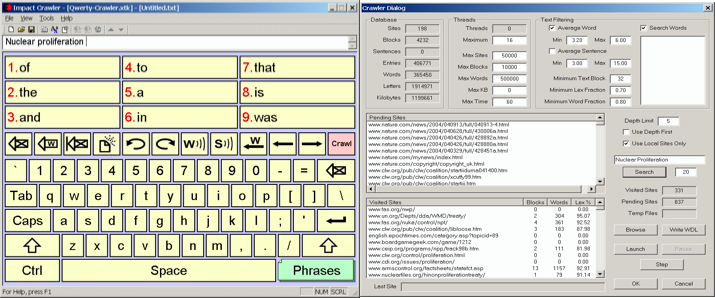|
Goals
The goal for this project is to integrate an autonomous WebCrawler with communication software to provide AAC users access to a domain appropriate communication materials. An AAC user will request vocabulary on a specific domain, either through pre-programmed buttons or through user-specified keywords. The search request will be transferred to a server hosting the WebCrawler, which will search the Internet for domain-appropriate texts. After collecting a pre-defined amount of text, a "distiller" program will convert the raw text into a format suitable for the communicator:
- literacy access,
- utterance-based communication,
- word prediction,
- biasing word predictors,
- topic-related vocabulary,
- topic specific - graphic image archiving, and
- topic specific - sound file archiving.
This information will be fed back to the communication device and presented to the AAC user in the form of domain-specific vocabulary, phrases, or sentences. As an example, an AAC user might request a vocabulary suited to a particular topic in school (e.g. biology or American history) or relevant to a conversation at hand (e.g., a popular movie or musical group).
Progress to Date
A prototype Webcrawler was designed using the Enkidu Research Emulator equipped with a QWERTY keyboard with word prediction. To invoke the webcrawler the operator enters search term(s) using the keyboard, then selects the special “Crawl” key on keyboard to start the search process. Within 30 seconds, the search engine (e.g., Google, Yahoo) generates an initial site list. he crawler searches and collectd information from these initial sites and their decendents. The Webcrawler system then analyzes content to create topic-specific prediction database. At that point, topic-specific words start appearing in prediction list as operator types. The Webcrawler dialog box is used to customize the parameters of the webcrawler search (e.g., number of initial and decendent sites searched, minimum size of a text block, word and sentence length).

The Flash™ Video of the Webcrawler Application in Action.
(to play the Flash™ video, right-click on the image below then select PLAY from the drop-down list).
When the video begins to play, this is what you will see: First, the operator spells out " Abraham Lincoln signed the em(ancipation)", taking 24 keystrokes. Note that only the words "signed" and "the" are predicted by the word predictor; the words "Abraham", "Lincoln" and "emancipation" are not.
After the display is erased, the operator types in the search term "Abraham Lincoln", then clicks on the crawler button (yellow "c" below the menu bar) to initiate the web search for information related to "Abraham Lincoln. After 10 seconds, the crawler has finished searching, processing and priming its word prediction system. When the operator begins to type the original sentence a second time, all words are predicted in 10 keystrokes, resulting in a 58% keystroke savings.
We have conducted several experiments to verify the production efficiency of the Webcrawler (Luo, Higginbotham & Lesher, 2007; see link below for handout). In summary we have found that efficiency improvements are discourse genre dependent. Improvements in keystroke savings were noted for written expository texts, but not for general topic spoken conversation texts. Effeciency improvement were also related to the specific topic being written about. Finally, we found that webcrawling improves performance for both core and fringe vocabularies. We were able to show that core vocabularies vary both by discourse genre and topic. Current Work on the webcrawler focuses on developing a stand-alone crawling engine that can be used with different communication device applicaitons.
Next Steps
We are redeveloping the webcrawler application as a stand-alone module to be used with different AAC applicaitons. We are also collaborating with Melody Moore and Carrie Bruce (Co-PI's) at the RERC for Workplace Accomodations on their AwareComm: Context Aware Communication for the Workplace Project.
Presentations
Luo, F., Higginbotham, D.J., & Lesher, G. (2007). AAC Webcrawler: Enhance Augmentative Communication. Paper presented at the Annual CSUN Conference on Disability Technology, March, Los Angeles.
|

